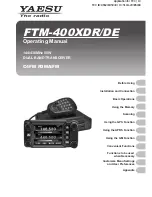
2-1. Mount the Receiver inside the operator cover.
2-2. Attach the antenna to the Receiver. An extension
cable will be required if the operator cover is
metal. Ideally, antenna should be vertical and in
line-of-sight of the Transmitter(s).
2-3. Connect power (12-24 VAC/DC) to the terminals
marked POWER (not polarity sensitive).
Determine which monitored interface your
operator uses. Connect the COM and the
correct output connections (P/N.C., 10K) to your
operator. The Output Select dip switch 1 is
set to “R” for all operator’s requiring either a N.C.
or a 10K input, or set to “P” for operator’s that
require a pulsed input. Switch 2 has no function.
2-4. Apply power to the Receiver. Observe that the
green and yellow LEDs are on. The Channel 1
red LED will blink, and the Channel 2 LED will be
on solid. After 15 seconds, the Channel 2 LED will
go out, unless there is a Transmitter associated
with it. If the yellow LED is blinking randomly, at
least one Transmitter has been Learned and is
working.
P.O. Box 159 • West Grove, PA 19390 • 800-220-3343 • 610-869-4422 • Fax: 610-869-4423 • www.milleredge.com
6809 South Harl Avenue, Suite A • Tempe, AZ 85283 • 800-887-3343 • 480-755-3565 • Fax: 480-755-3558
MGL-K20_Inst_20160815
Model: MGL-K20
INSTALLATION INSTRUCTIONS
IMPORTANT:
READ AND UNDERSTAND ALL INSTRUCTIONS BEFORE BEGINNING INSTALLATION
Kit Contents:
1. MGL-TX20 Transmitter unit
2. MGL-RX20 Receiver unit
3. Receiver antenna
4. (2) AA lithium batteries
5. (4) #6 pan head transmitter mounting screws
1-
Parts List
PART NUMBER
2-
Install Receiver
The Monitored Gate Link (MGL) transmitter/receiver system is intended to provide a wireless connection between a monitored
safety edge and a motorized operator that controls the associated gate. MGL meets the 2016 UL 325 requirements for
monitored devices and has been certified as a UL 325 recognized component. It is designed for use on operators that comply with
2016 UL 325 using a T2 terminated edge sensor.
Required:
1. 1/8” flat blade screwdriver
2. 1/4” flat blade screwdriver
3. 10K (T2/blue band) terminated Sensing Edge
Recommended:
• VOM for test purposes
• Mounting screws as required for receiver
ANTENNA
MOUNTING
TABS (2)
RECEIVER
ENCLOSURE
TERMINAL
DIAGRAM






















